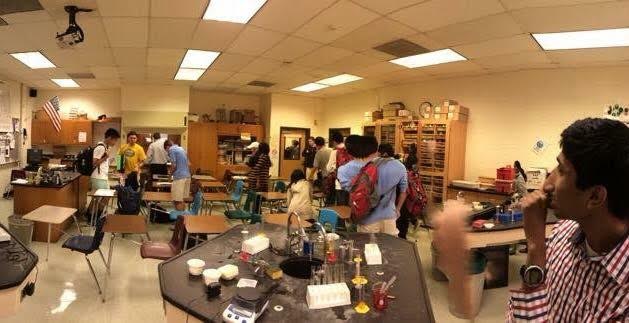Oh NO_2!
November 12, 2015
RINGGG RINGGG
Please be advised of this important message from the Bernards Township School District…
Intrigued, students hopped up from their desks and dinner tables. Was it a delayed opening or an annoying school picture reminder?
Bernards Township Emergency Services responded to Ridge High School Tuesday evening to investigate a potential chemical exposure in a chemistry laboratory located in room 313 of the school…
At the intersection of the 300 wing and the atrium, Room 313 houses numerous chemistry classes and labs. On September 15, around 12:30 pm, AP Chemistry students were preparing materials for a lab to be conducted the following day. The objective of the lab was to find the percent mass of copper in a brass bullet, made of a metal alloy (mixture) of copper and zinc. When dissolved in nitric acid[1], the bullet disintegrates, and the released copper ions color the solution with a vivid blue hue. In conjunction with Beer’s Law, a relationship between absorbance and transmittance, the intensity of the blue color would indicate the concentration of copper. From there, students would use the data values of concentration to calculate the percent mass of copper.
One by one, the lab pairs worked under the fume hood and dropped the brass bullets in small beakers filled with nitric acid solution.
plop! fizz…
“A fairly thick brown reddish gas was already hovering over the collection of beakers under the fume hood, recalls eye-witness Thomas Mazumder ‘17. “Some of us wondered what the gas was, but assumed it was not important to the experiment.”
Nothing appeared awry… at first. Soon all ten beakers were unleashing reddish coppery gas which billowed out from under the fume hood. By the time everyone concluded their lab preparation, several students noted alarming changes to the room.
“The gas had spread out of the fume hood by this point. The whole end of the classroom surrounding the fume hood was tinted yellow, as if I was wearing toy glasses made of yellow plastic,” Mazumder ‘17 details, describing how the room’s normally white fluorescent lighting seemed tainted with a yellow cast. Mazumder continues, “Looking on from the other side of the room, the color of the gas was so striking that I decided to take a little panorama.” He provided the photo that accompanies this article.
In the meantime, other students complained of an irritating odor that permeated the classroom. Ben Zhou ‘16 explains, “One of my friends noticed a strange smell, to which we ignored. Soon, the odor became unbearable as it spread around the room.” The Centers for Disease Control and Prevention describes nitrogen dioxide as a gas with a “pungent, acrid odor” which irritates the respiratory system.
Even at this point, no one had exhibited any symptoms or had any idea that poisonous nitrogen dioxide had diffused around the classroom. RINGG. All the students rushed out to attend their 8th period classes without casting a second glance at the lab area.
According to Alekha Kolli ‘16, “Retrospectively, we should have known that something was going on. The room turned yellow, and that’s never a good sign. But we literally had no idea.” As Kolli expresses, while many students noticed the warnings, none of them realized the potential gravity of the situation until they heard the blast district phone call.
RINGGG 8:30 pm
Most Ridge families were unfazed, but for the 20 families of the afflicted students, panic ensued. Recalling the startling call, Mazumder explains how he and his mother “both grew flustered and scared that the school mentioned that I was exposed to a poisonous gas!” Meanwhile at the Zhou household, Zhou described, “My mom received the blast message and started exclaiming about hospital visits and stuff. To be honest, I was just eating (like I always do) and didn’t give a second thought to it. But after conversing with friends, I started analyzing my breathing patterns and looking up the horrifying effects on WebMD.”
Did anything happen to the students? During the moments of panic, students seemed suddenly gripped by hyperventilation as they searched for answers. Luckily, once the anxiety subsided, the two lads as well as the rest of the class experienced no symptoms. In fact, numerous students partook in regular sports practices, ensemble rehearsals, and other activities with no breathing issues. Zhou quips, “Thankfully, nothing happened. #placeboeffectbutnotreally.”
So what actually went wrong? After investigation, it was discovered that the fume hood was not fully activated. Instead of vacuuming the toxic air out, the fume hood had let the nitrogen dioxide escape and flood the classroom.
In the chemical reaction generated by the experiment, nitrogen dioxide is released. A highly toxic gas, nitrogen dioxide (in large amounts) can move beyond eye, skin, and mucous membrane irritation to catastrophic consequences including death due to respiratory failure. Fortunately, the students were only in the ventilated classroom with the gas for approximately ten minutes. AP Chemistry teacher Mr. Smith elucidates, “To have harmful effects, there would have to be a lot more exposure. You would need to be in the smoke.”
If students were exposed to a miniscule amount of gas, why produce mass panic with the district-wide message? Explaining the rationale behind the call, Mr. Smith states, “There were no reported issues but symptoms could manifest 2-3 days from initial exposure, so we took the ‘ultra-defensive’ and sent out the precaution to be ‘better safe than sorry.’” Thus, the call served more as an informative and cautionary measure rather than an indicator of actual emergency.
From this incident, Ridge can glean an important lesson: safety precautions should not be taken too lightly. As trivial and at times ridiculous laboratory contracts and quizzes may seem, knowing how to proceed in times of emergency will make sure everyone remains safe.
[1] The unbalanced equation of the reaction is: Cu(s) + HNO3(aq) → Cu(NO3)2(aq) + NO2(g) + H2O(l)

